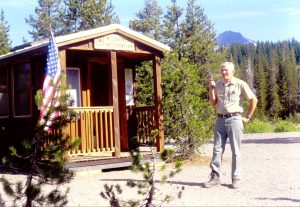Volunteer John Flood, M.D., staffed the Green Lakes Trail Head
Information Station for several summers.
By Les Joslin
“Now I want you to recruit and train and supervise wilderness volunteers to work at the trailhead so you can get back on the trails,” Marv responded to my written report on the Green Lakes Trailhead Information Station’s first summer of operations.
With this license, and eschewing such terms as “trailhead host” and “information kiosk” used by Marv and others, I set about recruiting a small group of volunteer “wilderness information specialists” possessed of first-hand knowledge of the Three Sisters Wilderness to operate the “information station” as uniformed Forest Service representatives. The station would be open nine hours daily from July 1 through Labor Day and on weekends into the fall.
“Working alone or in pairs,” my recruiting brochure and news releases advised, “volunteers will assist wilderness users and other national forest visitors by providing information and explaining the wilderness permit system, regulations, and etiquette. They will also gather visitor statistics and maintain trailhead facilities. Additional duties may include trail patrols.”
I laid out the details, and did so in a way that set the tone I intended as it assured potential volunteers they would not be just hanging out at a trailhead but doing a real Forest Service job for free.
Qualified persons at least 18 years of age who can commit at least one day per week may apply. In addition to familiarity with the Three Sisters Wilderness, volunteers should possess strong interpersonal skills and be physically capable of performing the full range of trailhead duties. Additional qualifying experience might include previous Forest Service or similar public contact service and relevant education. Current first aid and CPR certification also is useful. The Forest Service will provide supervision, pre-season and first-day on-the-job training, uniforms, and equipment. Volunteers are not considered federal employees, but they do receive legal protection as well as insurance for work-related injuries and reimbursement for certain expenses.
“The Forest Service,” I assured them, “needs reliable volunteers to supplement its small wilderness ranger force.” People who “are qualified, enjoy working with people, and would like serving as a ‘friendly face and a helping hand’ in the Three Sisters Wilderness this summer,” were invited to contact the Bend Ranger Station or me.
This challenging invitation attracted a few good volunteers from all walks of life. Two who proved the most active were Bend residents Larry Robertson, a retired General Motors executive engineer and former head of the Mount Bachelor ski patrol, and his wife Marian. Larry, a native of Corvallis, Oregon, and an Oregon State College aeronautical engineer who served as a U.S. Navy aviation maintenance officer during World War II and later helped design the Corvair and defend it before Congress from Ralph Nader, served at the trailhead station two or three days a week that summer and the next. As the summers went by, others included both active and retired Central Oregon doctors, lawyers, armed forces officers, and other professionals and retirees. Still others were college students who—along with Central Oregon Community College and Oregon State University, for both of which I taught part-time—eventually added another dimension to the project.
Training those volunteers—whom I referred to as Wilderness Information Specialists—at the trailhead station, staffing the station myself when no volunteer was scheduled, and patrolling trails while continuing the campsite surveys I’d begun in 1990 put me in the field for fifty-nine of the seventy-four days the station served over six thousand visitors that second summer.
Even after the previous summer’s shakedown, a few issues remained to be resolved. One of these was overnight wilderness permits. Day-use permits were self-issued at the trailheads, but overnight permits had to be obtained from a forest officer at a ranger station, and that could mean a sixty-mile roundtrip to Bend. On July 3, I made the case for trailhead volunteers to issue overnight permits to the Deschutes National Forest community affairs staff officer when he visited the station. “To the public, this is a ranger station.” On July 9, the Green Lakes Trailhead Information Station was authorized to issue overnight wilderness permits. A few years later, overnight permits, too, were self-issued at trailheads.
The success of the volunteer program begun at the Green Lakes Trailhead Information Station that summer of 1993 is reflected in statistics for the fourteen years during which a total of ninety-five uniformed volunteers I trained and qualified worked with me to staff the station for 997 days—8,560 hours—during which they represented the Forest Service and the wilderness concept to about 82,500 wilderness visitors and served another eight thousand Deschutes National Forest visitors who stopped by the station for other assistance and information. Add to those numbers the many wilderness visitors served by these same volunteers who staffed the Devils Lake wilderness trailheads about fifteen to twenty days annually for many of those years and patrolled wilderness trails, and the positive presence of these wilderness volunteers well exceeded ten thousand hours of service to more than one hundred thousand visitors served.
